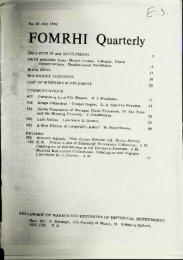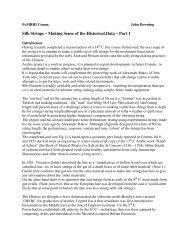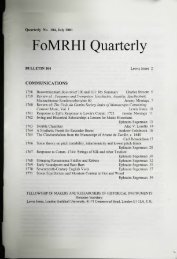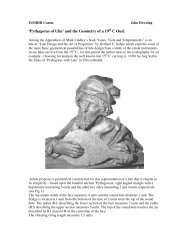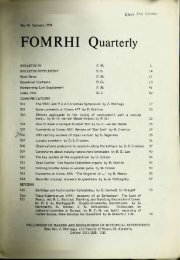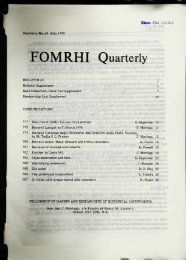•rf - FoMRHI
•rf - FoMRHI
•rf - FoMRHI
Create successful ePaper yourself
Turn your PDF publications into a flip-book with our unique Google optimized e-Paper software.
<strong>FoMRHI</strong> Cor*. 44<br />
REVIEW: INSTRUMENTS OF THE MIDDLE AGES AND RENAISSANCE BY<br />
DAVID MUNROW, 1976 and THE WORLD OF MEDIEVAL AND RENAISSANCE<br />
MUSICAL INSTRUMENTS BY JEREMY MONTAGU, 1976<br />
E Segerman<br />
Most scholars in the early music field feel that offering the products of research<br />
to the concert and instrument-buying public as it happens is very naturai and healthy.<br />
They are learning more and more about how and on what early music was really done,<br />
and the performers and instrument makers are getting better and better at recreating<br />
it. Thus. if mistakes are made in ignorance along the way and if there is a time lag<br />
in the response of performers and instrument makers to the research because of<br />
their investment in old ways, it will stili ali come out as authentic as can be in the<br />
end. It is in this spirit that these books on early instruments were written.<br />
For the scholars this practical realisation of their work is most stimulating, but<br />
there is a very serious danger when we consider the effect of communication of false<br />
information to the concert audience and the instrument buyers whose commitments are<br />
primarily to musical appreciation and expression and only secondarily to historical accuracy.<br />
The problem is one of initial aesthetic commitment, analagous to imprinting in<br />
animai beahviour. Readers of Conrad Lorenz will know that baby geese will follow<br />
the first nioving object they see after hatching, and if it happens to be Lorenz , the<br />
real mother goose gets ignored. We ali know that first impressions are the most<br />
lasting. I have been spoiled from enjoying the more authentic 6onorities of recent<br />
performances of those Monteverdi pieces that moved me so when I first heard them<br />
in the 1936 Nadia Boulanger recording . That recording is the only meaningful<br />
performance for my personal aesthetics and this is most disturbing since I intellectually<br />
know better.<br />
As any propogandist knows. information offered to the public when they are highly<br />
receptive to it sticks so tenaciously that subsequent refutations of errors can never<br />
be more than partially effective. When people are shown that they have been misled<br />
the usuai reaction is annoyance and rejection; the danger then is^when members of<br />
the public realize that they have been misinformed,they will either turn away from<br />
early music or reject authenticity as a significant factor to strive for (as has happened<br />
with the folk music movement).<br />
Both authors have acquired deep understanding of certain classes of early instruments<br />
and could write authoritatively about these, but it is somewhat impossible to attempt<br />
comprehensive books on early instruments when much of what is written involves the<br />
interpretation of the work of others that the authors have not understood on such a<br />
deep level. It is perhaps unfair that this review is written by me who can only claim<br />
some compctence in the area of strings, an area in which the authors could be expected<br />
to be the weakest. But since we ali agree on the supremacy of strings for 'serious'<br />
early music, the needs for accuracy in this area are most pressing. A commentary<br />
on the contentious points of the strings sections of both books was supposed to be part<br />
of this review, but it is becoming so long and taking so much time (being the prime<br />
reason for the delay in production of this issue) that it will needs be a separate<br />
communication in the next issue.<br />
-5"0-





